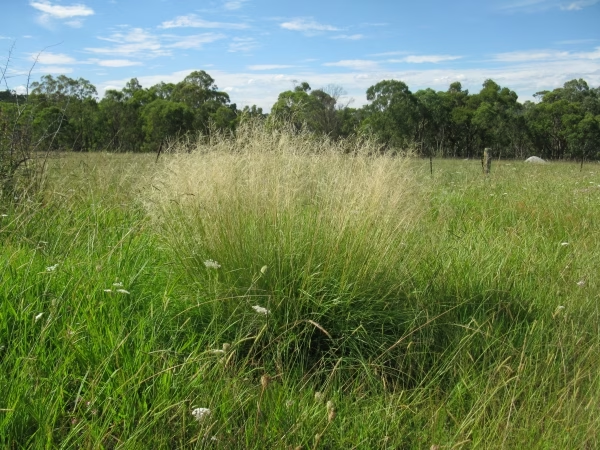
Weeping Lovegrass
Botanical Name
:
Eragrostis curvula
Plant Type
:
Warm-season perennial bunchgrass
Seasons
:
Active growth in late spring and summer; goes dormant in fall and winter
Sun Level
:
Full sun (at least 6–8 hours per day)
Ideal Soil Temperature for Planting
:
60–85°F (16–29°C)
Soil Type
:
Well-drained, sandy, or loamy soils but can tolerate poor, rocky, and eroded soils
Hardiness Zones
:
6–10 (USDA)
Germination
:
7–21 days, best results when seeds are planted shallowly (¼ inch deep)
P.H. Level
:
5.0–7.5
Water/Irrigation
:
Drought-tolerant once established but requires regular watering during establishment
Fertilization
:
Apply fertilizer containing nitrogen (N), phosphorus (P), and Potassium (K) before seeding, with a second N feeding applied in mid-summer
Habit
:
Forms dense, clump-like tufts with arching, weeping foliage
Final Plant Height
:
2–4 feet
Spread
:
By tillering. Over a year, a single weeping lovegrass can colonize an area 12-15 inches in diameter
Spacing
:
3 to 5 pounds per acre
Flowers
:
Produces feathery, reddish-purple seed heads in mid-to-late summer
Attracts
:
Provides shelter for small wildlife and attracts pollinators
Uses
:
Erosion control (commonly planted on slopes and roadsides)
Ground cover in dry, poor soils
Forage for livestock (though not the most nutritious)
Ornamental grass for landscaping
Companions
:
Other drought-resistant grasses, wildflowers, and native perennials
Pruning
:
Trim back dead foliage in early spring to encourage new growth
Toxicity
:
Non-toxic to humans and pets
Pests
:
Generally pest-resistant; occasional grasshoppers or aphids
Diseases
:
Resistant to most diseases but may be affected by rust or leaf spot in wet conditions
Fun Fact
:
The “weeping” name comes from its long, narrow arching leaves that suggest the grass is “weeping”
Botanical Name
:
Eragrostis curvula
Plant Type
:
Warm-season perennial bunchgrass
Seasons
:
Active growth in late spring and summer; goes dormant in fall and winter
Sun Level
:
Full sun (at least 6–8 hours per day)
Ideal Soil Temperature for Planting
:
60–85°F (16–29°C)
Soil Type
:
Well-drained, sandy, or loamy soils but can tolerate poor, rocky, and eroded soils
Hardiness Zones
:
6–10 (USDA)
Germination
:
7–21 days, best results when seeds are planted shallowly (¼ inch deep)
P.H. Level
:
5.0–7.5
Water/Irrigation
:
Drought-tolerant once established but requires regular watering during establishment
Fertilization
:
Apply fertilizer containing nitrogen (N), phosphorus (P), and Potassium (K) before seeding, with a second N feeding applied in mid-summer
Habit
:
Forms dense, clump-like tufts with arching, weeping foliage
Final Plant Height
:
2–4 feet
Spread
:
By tillering. Over a year, a single weeping lovegrass can colonize an area 12-15 inches in diameter
Spacing
:
3 to 5 pounds per acre
Flowers
:
Produces feathery, reddish-purple seed heads in mid-to-late summer
Attracts
:
Provides shelter for small wildlife and attracts pollinators
Uses
:
Erosion control (commonly planted on slopes and roadsides)
Ground cover in dry, poor soils
Forage for livestock (though not the most nutritious)
Ornamental grass for landscaping
Companions
:
Other drought-resistant grasses, wildflowers, and native perennials
Pruning
:
Trim back dead foliage in early spring to encourage new growth
Toxicity
:
Non-toxic to humans and pets
Pests
:
Generally pest-resistant; occasional grasshoppers or aphids
Diseases
:
Resistant to most diseases but may be affected by rust or leaf spot in wet conditions
Fun Fact
:
The “weeping” name comes from its long, narrow arching leaves that suggest the grass is “weeping”
Written by Salome Wapukha – https://www.linkedin.com/in/salome-wapukha-556700193/

